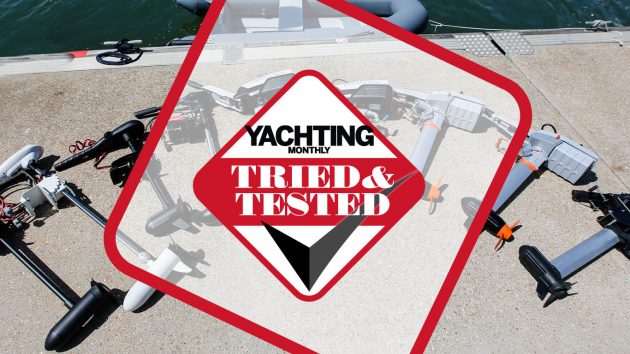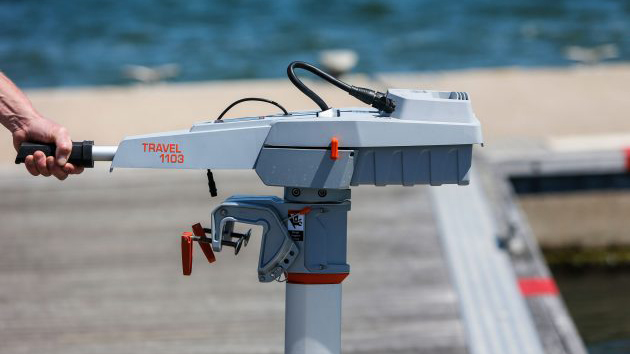An electric outboard motor is now a viable option for dinghy propulsion. Emrhys Barrell puts the latest outboards and trolling motors to the test
The electric outboard motor has been around for many years, but they have either been too low powered or their lead acid batteries have made them too heavy to lift in and out of a small tender, so petrol outboards have remained the engine of choice.
The development of lightweight lithium batteries has changed all this, making the choice between electric or petrol outboards less clear cut.
With this in mind, we gathered together some of the top performing models to put them to the test. For the purposes of our testing we’ve tried to stick to models whose all-up weight, or the weight of their individual components, did not exceed the 14-17kg of a 2.5hp petrol outboard.
This is exactly the sort of electric outboard that you would use with an inflatable tender for short journeys (which is to say the most popular type).
See how we tested the electric outboards at the end of this article.
Best electric outboard motor
Torqeedo 1103
Specifications: Motor weight: 11kg | Battery weight: 6kg | Battery capacity: 915Wh | Top speed RIB: 4.4mph | Top speed skiff: 6mph
Reasons to buy: Established brand with relatively long history | Removable battery and tiller | Lots of display options
Reasons to avoid: Display hard to read
The Torqeedo 1103 is 1.1kW and has a removable battery and tiller/throttle. The battery locates in slots in the powerhead and can be dropped in one-handed, with the slots clearly visible from above, which is helpful in a rocking dinghy. It then hinges back and locks in place with a separate plastic pin. The tiller locates in similar slots.
The motor has four trim positions to allow for angled transoms, but the split ring securing the locking pin is very stiff and fiddly, especially when you have to adjust it hanging over the transom. A side-mounted lever allows the motor to be tilted horizontally. In normal use a catch prevents the motor kicking up in reverse, but this can be released with another side-mounted lever if you are in shallow water.
Long and short shaft versions are available, with the height of the transom to the top of the prop on the long shaft being 62cm. Clamps screws and fittings are stainless steel, making it suitable for salt water use, but an anode is an extra. It has forward and reverse but not 360º rotation.
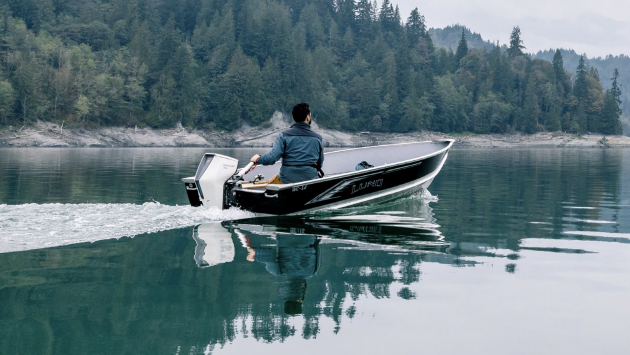
Mercury Avator 7.5e
Specifications: Motor weight: 16.7kg | Battery weight: 7.6kg | Battery capacity: 1kWh | Top speed skiff: 6mph
Reasons to buy: The claimed 34nm range at 25% throttle is the best we’ve seen
Reasons to avoid: Heavier than some of the competition
Announced in early 2022 and launched less than a year later, the Mercury Avator 7.5e is the first electric unit from the world’s biggest builder of outboard engines.
The whole top plate hinges up to reveal the battery, which can be quickly removed from your electric boat or replaced for convenient charging.
It’s by no means the lightest electric outboard motor on the market, but its claimed range at 25% throttle is very impressive – we look forward to putting one to the test.
Not resting on its laurels, Mercury launched the Avator 20e and 35e this summer as well. These units are no bigger than the 7.5e, but need wiring in to an on-board battery bank.
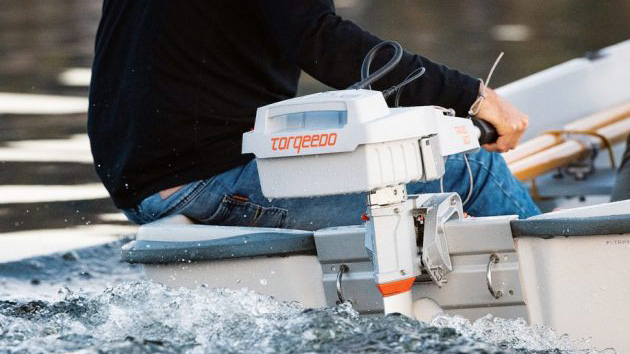
Torqeedo Travel 603
Specifications: Motor weight: 11.3kg | Battery weight: 4.2kg | Battery capacity: 500Wh | Top speed skiff: 4.4mph
Reasons to buy: Torqeedo is a tried and trusted manufacturer | Great app connectivity etc.
Reasons to avoid: Limit range and speed due to small size
Torqeedo has been making electric outboard motors for quite a while now, and their latest offering slots into the travel range of electric outboards between the 503 (1.5hp) and the 1103C (3hp).
All the usual Torqeedo refinements are present and correct. IP67 rated as totally waterproof, the 603 Travel has a magnetic kill cord and an onboard computer providing instant readouts of operating range at current RPM and battery-charge status displayed on the tiller arm.
You can link it to an Apple or Android app and gain even more information including a map-based range indicator.
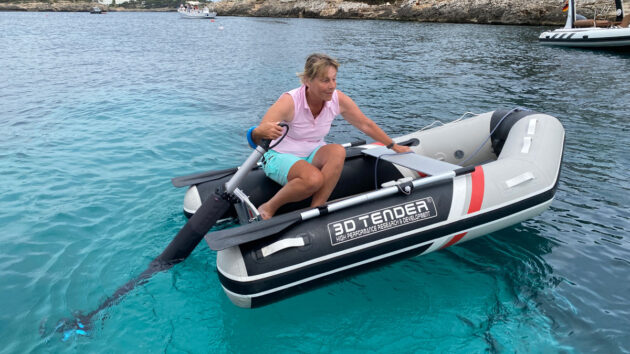
Temo 450
Specifications: Motor weight: 4.9kg | Battery weight: N/A | Battery capacity: 290Wh | Top speed skiff: 3.4mph
Reasons to buy: Compact and novel | Allows for unique manoeuvring once you are used to it
Reasons to avoid: Takes some getting used to | Relatively slow
This Temo is unlike any conventional outboard, electric or petrol, that we’ve seen before and attaches like a dinghy paddle. The metal rod passes through a pivot point and then with a screw bobbin on the top. Simple, quick and very easy.
The tiller handle extends to balance the propeller in the water at just the right depth and to give a comfortable position to steer with. The shorter the handle the heavier the steering, but the prop sinks deeper.
They say it’s equivalent of a 2hp, but the design of it makes it hard to compare to anything conventionally driven. I like the low-profile design, the speed of mounting and dismounting, the ease of carrying and stowing and the speed it charges.
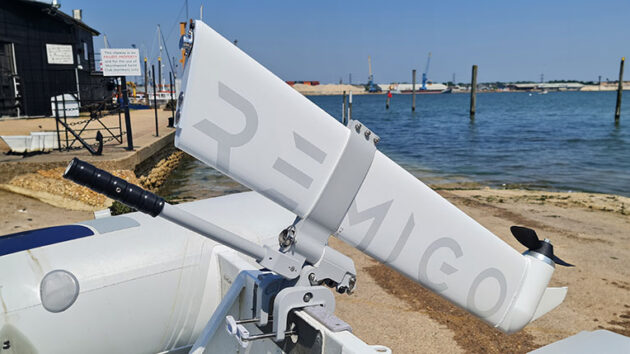
Remigo One
Specifications:Motor weight: 12kg | Battery weight: N/A | Battery capacity: 1.085 kWh | Top speed skiff: 5.8mph
Reasons to buy: Very easy to stow | Innovative rudder design | Lightweight built in battery
Reasons to avoid: No multiple battery swap options like more conventional electric outboards
Antother integrated engine design, the Remiogo One is designed along the lines of a dinghy rudder, this makes it incredibly easy and intuitive to use. No external cables or anything to be snagged, it clips onto a bracket pre-mounted to your tender or dinghy, in a similar way that you’d attach a dinghy rudder.
Flip down the handle, attach the magnetic kill cord and you’re good to go.
On test this outboard gave as much thrust as the ePropulsion below but out performed it in terms of maneuverability. The Remigo can be switched from forward to reverse thrust at the touch of a button.
We like the Remigo for it’s sleek simplicity. If you want a clean smart easy to carry outboard to take you from your mooring to shore or quietly meander from your anchorage to shore then this is definitely worth considering.
We especially liked the rudder effect of this outboard giving us steerage even we had turn the power completely off to coast in alongside our pontoon.

Photo: Paul Wyeth
ePropolsion Spirit 1.0 EVO
Specifications: Motor weight: 10.5kg | Battery weight: 9kg | Battery capacity: 1276Wh | Top speed skiff: 6.0mph
Reasons to buy: High battery capacity | Quiet | 360º rotation
Reasons to avoid: Limited display options
The Chinese firm ePropulsion has been developing its electric outboard motor range and lithium batteries for some time. We tested the Spirit 1.0 Plus and Evo, both 1kW motors with integral batteries.
Clearly ePropulsion was influenced by Torqeedo, but there are some important differences. From the outset ePropulsion went for a direct drive motor, being quieter and avoiding gearbox problems.
The battery has a greater capacity than the original Torqeedo, and is still 30% higher than the latest version. It also floats – useful if you should drop it overboard.
Fitting the battery is a two-handed job, with the carrying handle being at the back, and latch lock at the front, which requires leaning over the transom to install it. You also cannot see the locating slots underneath, which isn’t quite so easy in a bobbing inflatable. The power cable socket is protected by a rubber cap.
You have a display, but it only shows power being consumed, voltage, and remaining runtime, which means it has larger figures, easier to read on a sunny day, but it lacks GPS speed or range.
It has the same trim settings as the Torqeedo, with a similar fiddly retaining split ring. It also has a magnetic kill cord. Three shaft lengths are available, catering for transom heights up to 61cm. The shaft is streamlined but rotates through 360º for maximum manoeuvrability and reverse.
Best Trolling motors
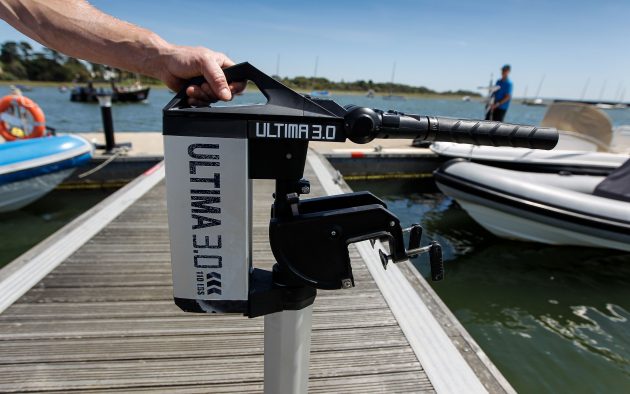
Photo: Paul Wyeth
Haswing Ultima 3
Specifications: Motor weight: 11kg | Battery weight: 5kg | Battery capacity: 600Wh | Top speed: RIB 4.0mph
Reasons to buy: Easy to fit battery | Anode as standard for salt water usage | High end materials
Reasons to avoid: Limited instrumentation
Haswing is a new name to us, but this Chinese manufacturer now has an extensive range of motors, several of which we were able to bring along to our test.
The Ultima 3 has an integral Lithium battery and an output of 1,000W, with the ‘3’ in its name indicating the 3hp petrol outboard its makers claim it is equivalent to. The battery is 600Wh.
The battery was the easiest of all in our test to fit and remove, just sliding down a set of grooves, with contacts in the bottom removing the need for any linking cables or wires, and an easy one-handed operation.
The unit is well engineered, with stainless steel used throughout plus an anode as standard, making this suitable for use in salt water, and a spare anode and shear pin. The tiller/throttle hinges up and down for easy operation and storage. It has a streamlined aluminium leg, but rotates 360º.
A magnetic kill cord is a useful safety feature, and there are 5 LEDs showing battery capacity remaining, but this is the only instrumentation, so there is no way of gauging how much power you are using. It also meant that with no exposed power cables, we could not measure intermediate power settings.

Photo: Paul Wyeth
Motorguide Varimax 40
Specifications: Motor weight: 9.1kg | Battery (Sterling 60Ah) – 8kg | Battery capacity: 780Wh | Top speed RIB: 3.2mph
Reasons to buy: Clever throttle control | Variable transom heights accommodated
Reasons to avoid: Quite basic in functionality
Another trolling motor, this has a claimed 40lb thrust and a variable speed electronic control. The throttle pulls forward for ahead, and pushes back for reverse then twists in the same direction for speed. A clever feature once you get used to it. Ten LEDs show the battery state.
The sliding shaft gives transom heights up to 65cm transom to prop, and 360º rotation. It also quickly tilts through 90º, with 5 positions, for shallow or weedy water.
Clamp screws and fittings are mild steel, meaning you should wash it off with freshwater after using it in the sea.
Haswing Protruar 3
Specifications: Motor weight: 14kg | Battery weight: 16kg | Battery capacity: 1,560Wh | Top speed RIB: Not tested
Reasons to buy: Powerful model | Anode for salt water use | Battery LEDs and kill chord
Reasons to avoid: Needs two batteries for full power
Another Haswing, the Protruar 5 is the most powerful model we tested. The unit is extremely well engineered, with stainless steel used throughout for the clamp screws and fittings, plus an anode as standard, making this suitable for use in salt water. A nice touch is the spare anode and shear pin in the kit. The tiller/throttle hinges up and down for easy operation and storage.
Its 5 designation indicates its makers think it is equivalent to a 5hp petrol motor, but in reality it delivers around 2.5kW at 24V so requires two separate batteries. It has a variable electronic throttle, three battery state LEDS and a magnetic kill cord.
The shaft slides up and down, giving a maximum transom height of 62cm and 360º rotation. Ten tilt positions are quickly engaged by a squeeze lever.
The thrust was the highest of the test, making it suitable for heavy boats, but the fine pitch prop significantly reduced its efficiency at speed.
How we tested the best electric outboard motors
We took a selection of the very best electric outboard motor units available on the market, and tested them in two situations, firstly on a Frib 275 folding RIB on the Lymington River to reproduce the situation of getting out to your boat in the tender. We then put them on a 4m skiff on the Thames, to see how they perform at higher speeds on a boat with a smoother underwater form and longer waterline on sheltered waters.
Speed: We measured speed using a handheld GPS, and electricity consumed using a clamp ammeter or the motor’s inbuilt power display. We converted these to the range you would achieve, either for a given power, or the full power of the motor’s battery.
Thrust: We measured static thrust using a spring balance. This is a somewhat crude test, as it measures the pulling power of a motor in a static boat, and therefore doesn’t allow the propeller pitch to work at its designed speed.
Function: We checked the stated weights of each of the motors and made a qualitative survey of their main features when used as a dinghy outboard.
We tested the trolling motors with a 60Ah lithium battery from Sterling Power, which cost £360, though you can use a heavier lead acid battery costing around £120 for a good quality AGM or gel. Don’t bother with leisure batteries, which will fail after 4 to 5 trips. You will need a good quality Lithium charger, which will add on £100 or more.
We haven’t included charging in this test, as this is dependent on the charger you are using, whether you are charging from 240V or 12V on board, and whether the power source is mains, a generator, alternator or solar. It’s worth noting that you will rarely be recharging from flat, and will rather be aiming to top up batteries after each use.
Trolling motor or electric outboard motor?
The options today are trolling motors with separate batteries – so called because they were mainly used as auxiliary slow-speed power for anglers, and integral-battery motors built for dinghy propulsion. These are the options a sailor will be looking at when thinking about changing to an electric outboard.
Trolling motors are still popular for low-speed applications, as they are simple and cheap, but they do need a separate 12V battery.
The integral battery motors are sophisticated units designed to give you more speed and greater range for a given power in a small boat, though for any 3-4m boat, the hull speed will limit how fast you can realistically go with any motor unless you start planing.
An electric outboard motor with an integral battery will often include displays showing speed, range at a given speed, and percentage of battery capacity remaining, but these features come with a higher price tag.
The trolling motors and integral battery models in our test were similar in weight and both come in at around the same total weight as a 2.5hp petrol engine.
Enjoyed reading this?
A subscription to Yachting Monthly magazine costs around 40% less than the cover price.
Print and digital editions are available through Magazines Direct – where you can also find the latest deals.
YM is packed with information to help you get the most from your time on the water.
-
-
- Take your seamanship to the next level with tips, advice and skills from our experts
- Impartial in-depth reviews of the latest yachts and equipment
- Cruising guides to help you reach those dream destinations
-
Follow us on Facebook, Twitter and Instagram.




